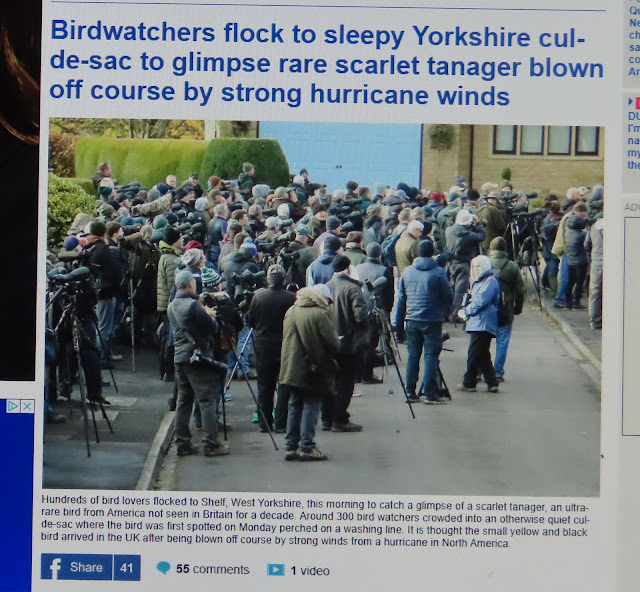 |
| How Mail Online has been reporting today's mass twitch in West Yorkshire |
A VAGRANT Scarlet Tanager that has turned up in a village in West Yorkshire was today catching the attention not just of birders but also of the national media.
Slightly larger than a House Sparrow, the species is a songbird that breeds in oak-rich forests in North America before migrating to similar wooded habitat in South America where it spends winter.
Reports today's edition of Mail Online: "Hundreds of bird lovers flocked to a sleepy West Yorkshire cul-de-sac this morning to catch a glimpse of an ultra-rare bird from America not seen in Britain for a decade.
"Around 300 bird watchers crowded into the road in Shelf, West Yorkshire, where the scarlet tanager was first spotted on Monday perched on a washing line.
"It is thought the small yellow and black bird arrived in the UK after being blown off course by strong winds from a hurricane in North America."
Yellow and black? That's because it is a first winter bird and not in its breeding plumage of spring and summer.
It is more than a possibility that the bird may have made part of its transatlantic journey by hitching a ride on a cargo vessel.
As many as 300 twitchers at a time have flocked to the scene - doubtless to the curiosity, amusement and consternation of residents.
It was back on October 4,1970, that the first occurrence of the Scarlet Tanager in Britain was recorded the Isles of Scilly
Birder B.D. Harding spotted it from a range of about 25 yards in a dead tree in the Porth Hellick area of St Mary's, Isles of Scilly.
Happily many others subsequently also saw the same bird.
Writing up his account for the April 1972 edition of British Birds journal, Harding describes his bird as "nearly as big as Corn Bunting but rather more dashing and having a relatively shorter and squarer tail and fairly long, broad, powerful wings".
He continues: "When perched upright it recalled a large finch with a long, stout bill.
"It usually perched motionless, eventually moving down into cover with a heavy, warbler-like action.
"The flight was fast and fairly direct, the bird dropping down from foliage, flying along a few feet above the ground, then sweeping up into a bush or tree.
"On two occasions it was seen to flycatch - once from the top of a tree, and once from a hedgerow over a field when it covered a distance of 25 yards before returning to its perch.
"In these performances it was very agile, twisting and turning erratically, hovering and almost looping the loop."
Since then, there have been three other Scilly birds, two in Cornwall and one in the Western Isles of Scotland.
Today's excitement in Yorkshire mirrors that experienced by a Canadian birder, Hamilton Laing, in autumn 1926.
It was not until six years later that he wrote up his experience for the December 1932 edition of The Canadian Field Naturalist.
"Few better examples of the unusual wanderings of our land birds could be shown than that of a Scarlet that I saw on November 17, 1926.
"I noted a green bird with black wings in a small cherry near my den window.
"As no such bird should have been in cherry trees at Comox on Vancouver Island in November, I gave chase.
"When I got outside the door, the bird had gone but a hunt in the surrounding woods disclosed it in the alders.
"It proved to be a young male tanager and with unpardonable carelessness I called the bird a belated Western Tanager and dismissed the case, never having seen the young of this species at this time of the year because of its early migration.
"Two years ago, however, on getting specimens of eastern birds I recognized my bird for what it is: the Scarlet Tanager, a species showing no other records for British Columbia, none for Alberta and few for Saskatchewan.
"This probably will stand as the most westerly record of the species for some time, though there still remains the width of the island to cross - a small matter to a bird adventurous enough to negotiate the plains and the western mountains."
Some 20 years later, the same publication reported a Scarlet Tanager in Nova Scotia.
Correspondent Harrison Lewis writes: "On May 1 and 2, 1952, I saw a male Scarlet Tanager at the home of Mr. Lawrence Perry on his farm in Central Chebogue, three miles southeast of the town of Yarmouth in Nova Scotia.
"This bird, in brilliant plumage, was watched by me for minutes at a time, at close range, on each of the dates mentioned.
"A binocular (x6) was used as much as was convenient.
"The tanager spent a large part of its time about the manure pile in the barnyard where it presumably obtained some insects.
"Members of the Perry family have informed me that this Scarlet Tanager appeared at Mr. Lawrence Perry’s home about the middle of April and remained there until about the middle of May."
 |
| Tanager treat - there have been plenty of tweets on X this afternoon |
No comments:
Post a Comment